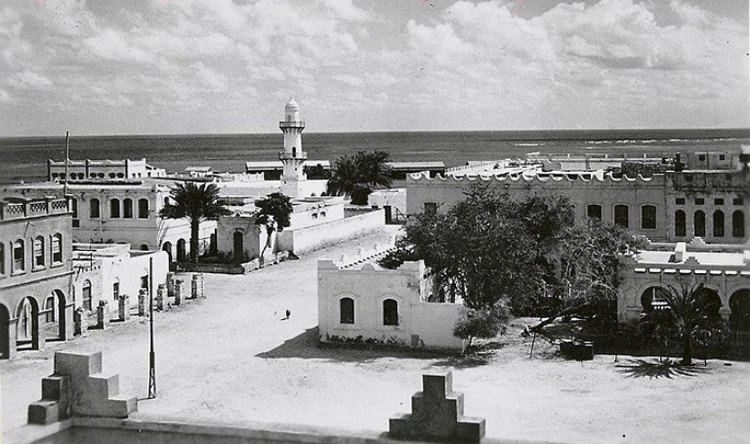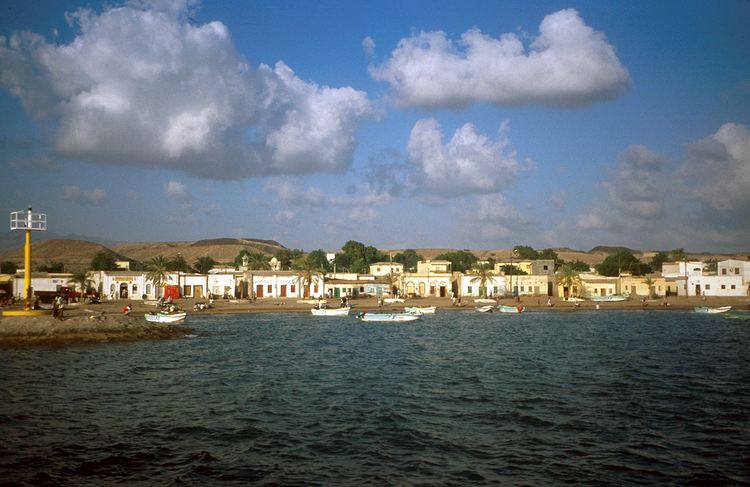Country Population 48,093 | Region Tadjoura | |
 | ||
Map of Tadjoura
Tadjoura (Afar: Tagórri; Arabic: تاجورة Tağūrah, Somali: Tajuura) is the oldest town in Djibouti and the capital of the Tadjourah Region. An important port for many centuries, it was ruled by a succession of polities, including the Ifat Sultanate, Adal Sultanate, the Ottoman Empire, France until Djibouti's independence in 1977. Lying on the Gulf of Tadjoura, it is home to a population of around 45,000 inhabitants. It is the third largest city in the country after Djibouti City and Ali Sabieh.
Contents
- Map of Tadjoura
- Bay of tadjoura arta djibouti
- Driving through tadjoura djibouti nov 2012
- Etymology
- History
- Climate
- Transportation
- Sultans
- Notable people
- References

Tadjoura has an airstrip and is linked by ferry with Djibouti City. It is also known for its whitewashed buildings and nearby beaches.
Bay of tadjoura arta djibouti
Driving through tadjoura djibouti nov 2012
Etymology
The Afar name Tagórri derives from the noun tágor or tógor, (pl. tágar meaning "outre à puiser" ("goatskin flask for drawing water"). The name Tagórri is specifically derived from *tagór-li, which means "qui a des outre à puiser" ("that which has goatskin flasks to draw water"), in effect meaning "abondante en eau" ("abundant with water").
History
During the Middle Ages, Tadjoura was ruled by the Adal Sultanate. It later formed a part of the French Somaliland protectorate in the first half of the 20th century.
While visiting Tadjoura in 1842, Charles Johnston was told that there could be found "stone walls of some extent, but completely in ruins," which "could be seen on the road to the well" between the town and a local well. Upon inspecting the site, Johnston "by raking over the spot with the butt end of a spear very evident marks of the foundations of some extensive buildings were to be seen, but were still too indistinct to enable us to form any idea as to their character." Questions about these ruins only informed Johnston that they were the work of "Turks", or "sometimes, as if correcting themselves, explaining that they meant the Feringees, for that the old possessors had not been Mahomedans but Christians."
According to Mordechai Abir, Tadjoura originally was the seat of the Afar Ad-Ali Abli Sultanate as well as a port. This ruler, known as the Dardar, "claimed authority over all of the northern Adoimara Afar to the borders of Showa. However, although it was true that some sub-clans of the Ad-Ali and Abli Adoimara roamed as far as the borders of Yifat, even the staunchest supporters of the Sultan agreed that his actual authority did not stretch beyond Lake Assal, a short distance from Tadjoura."
Richard Pankhurst notes that it differed from neighboring ports by handling almost entirely the trade of Shewa and Aussa, "rather than that of Harar or the Ogaden." He quotes William Cornwallis Harris' description of an annual bazaar that started each September, when "for two months the beach is piled with merchandise, and the suburbs are crowded with camels, mules and donkeys." Pankhurst also cites C.T. Beke that the trade with the inhabitants of the Afar Depression was handled entirely by women, "who loaded the camels, bought and sold while the men kept away altogether 'to avoid bloodshed, this country being the scene of constant feuds among the different tribes.'"
While Abir observes that the port is not mentioned in all of the material about the Red Sea in the eighteenth or early nineteenth centuries, by the mid-19th century Tadjoura was thriving, "while all the other so-called Afar sultanates along the coast were described ... as small decaying villages of no political or commercial importance." Tadjoura owed this success to possessing a major slave market; Pankhurst suggests that a rough estimate of 6,000 people a year left Ethiopia through Tadjoura and Zeila. The other important commodity sold in Tadjoura in the 19th century was ivory, brought by caravan from Aliyu Amba. Other goods exported included wheat, durra, honey, gold, ostrich feathers, senna, madder, and civetone. The value of trade in 1880-1 was estimated at the time as 29,656 rupees in exports and 18,513 rupees in imports.
Once Tadjoura came under French control, the slave trade was abolished by decree on 26 October 1889; however, Noel-Buxton reported that Tajoura still remained a center of the slave trade, but "limited to small though frequent shipments." While during the 1880s the port served as a distribution point for rifles and ammunition to Shewa and Ethiopia (during this period, Arthur Rimbaud lived in the city), Tajoura's importance inevitably declined with the construction of the Franco-Ethiopian railway, which connected Djibouti with the hinterlands. The railway began to carry traffic on 22 July 1901, was extended to Dire Dawa 17 months later, and finally to Addis Ababa on 3 December 1929.
The port of Tadjoura was modernized in 2000, at a cost of US$1.64 million, allowing it to handle cargo vessels and their contents. The work was described as part of the government’s effort to help the economic development of the districts of Tadjourah, Obock, Ali-Sabieh and Dikhil. The new port was formally opened by Djibouti president Ismail Omar Guelleh on 10 October.
Climate
Featuring an arid climate, the town sees on average 186 mm (7.31 in) of rainfall per year. Average temperatures range from 26 °C (79 °F) in winter to 36 °C (97 °F) in summer.
Transportation
From Djibouti City to Tadjoura takes two and a half hour ferry or three thirty dhow or a quarter of an hour by air or two hours by paved road (130 km). The first crossing of the Gulf must necessarily be by sea lot slower than by air, it presents more than charm. In its mountain environment, the white city presents its most attractive face when approached by sea small boxes of old wood gave way to brick houses, whitewashed. Here and there appear the minarets of mosques which give Tadjoura this special character that is its charm. For air transportation, Tajdoura is served by the Tadjoura Airport. The local port is the proposed terminus of a rebuilt standard gauge railway to Ethiopia.
Sultans
The following is a list of Sultans of Tadjoura:
